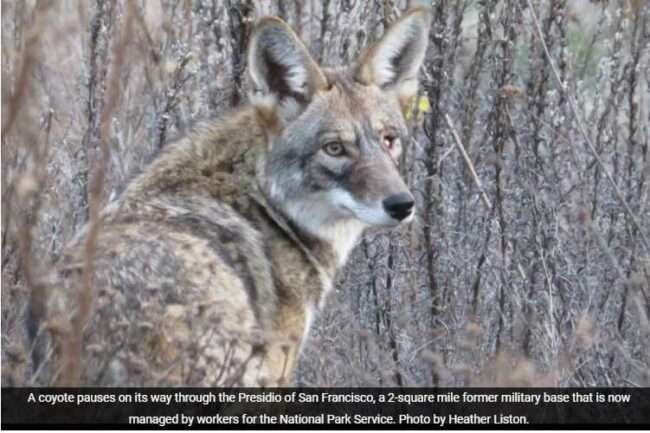A person is bound to notice changes if he bicycles the same pathways for 20 years. Such is the case in San Francisco, where the Fall Meeting of the American Geophysical Union was held last week, as it has been for many Decembers.
Some observations:
1. People are really happy to get together again after that option was taken away in 2020.
2. San Francisco has even more paths for bicycles than it did the last time I rode there in 2019. For example, the main thoroughfare through Golden Gate Park — John F. Kennedy Drive — is now mostly closed to cars but open for pedestrians and bicycles.
3. Since my bosses at the Geophysical Institute began paying my way to attend this conference in 1999, coyotes seem to have repopulated San Francisco.
Example of No. 3: My cousin Heather Liston promised me a coyote sighting as she walked me through the Presidio of San Francisco, a former U.S. Army base that occupies more than 2 square miles of prime real estate adjacent to the Golden Gate Bridge.
As we were hiking up one of the many trails through the Presidio, there appeared a coyote, quite close. Wary but accustomed to operating close to people, it crunched on the remains of something feathered. Heather got some nice photos before the coyote disappeared into the brush.
As I biked around San Francisco on the way to and from the conference site during the remainder of a sunny week, I saw three more coyotes, each in parks.
One night, while transiting one of the darker areas of Golden Gate Park using my bike light from Alaska, I thought I heard sirens, but the tones were a little off.
I braked to a halt. When my feet hit the asphalt, the eerie howls and yips of coyotes pierced the night. It sounded like 10 of them, but was probably not that many.
Coyotes’ recent occupation of one of the most densely human-populated cities in America may have started around 2003. That’s when a team led by Benjamin Sacks of the University of California, Davis extracted DNA from the blood of a male coyote captured in the Presidio and later returned there.
That coyote was related to the many that live in Marin County and other places north of San Francisco, Sacks found. This led him to deduce that the animal at some point trotted over the 1.7-mile Golden Gate Bridge, which features walking pathways on both sides of U.S Highway 101.
“Our findings reflect an example where a human modification to the landscape may have . . . facilitated gene flow between historically distinct sections of a species range,” Sacks wrote in a paper.
Biologists now estimate the San Francisco coyote population at 100 animals or so. Their reoccupation of the peninsula comes about a century after a final individual was reported in 1925 in Golden Gate Park.
Though coyotes had been native to San Francisco, they disappeared around then due to poisoning, hunting and urban expansion, Christine Wilkinson pointed out in a 2023 paper about the modern coexistence between coyotes and humans in San Francisco.
As for Alaska, coyotes arrived here just about a century ago, biologists think. In his 2016 book, “Coyote America,” author Dan Flores suggested that people aided coyote expansion from their core population in the western U.S. all the way down to El Salvador (possibly following domestic sheep herds) and up to Alaska (capitalizing on the scraps of gold miners and others who flooded the territory).
In San Francisco, Wilkinson wrote, “coyote-conflict reports have been significantly increasing over the past 5 years.” But many city dwellers also expressed a “desire for coexistence with coyotes.”
The latter seems to be the attitude of my cousin, and the mother with the baby strapped to her chest who watched two coyotes trot over a park lawn with me one evening.
Coyotes are now protected in San Francisco. It seems they will roam the city as long as they have quiet spots to have pups and can find urban food sources, such as wild rats and many other things.
As the giant conference that has brought me to San Francisco so many Decembers will be in Washington, D.C., next year — and who knows if we shall pass this way again? — a thank you from me to my cousin Heather, and my friend John Arntz, who has hosted me on his couch for so many San Francisco nights. And to the three Geophysical Institute directors who have over many years sent me toward the sunshine in December.

